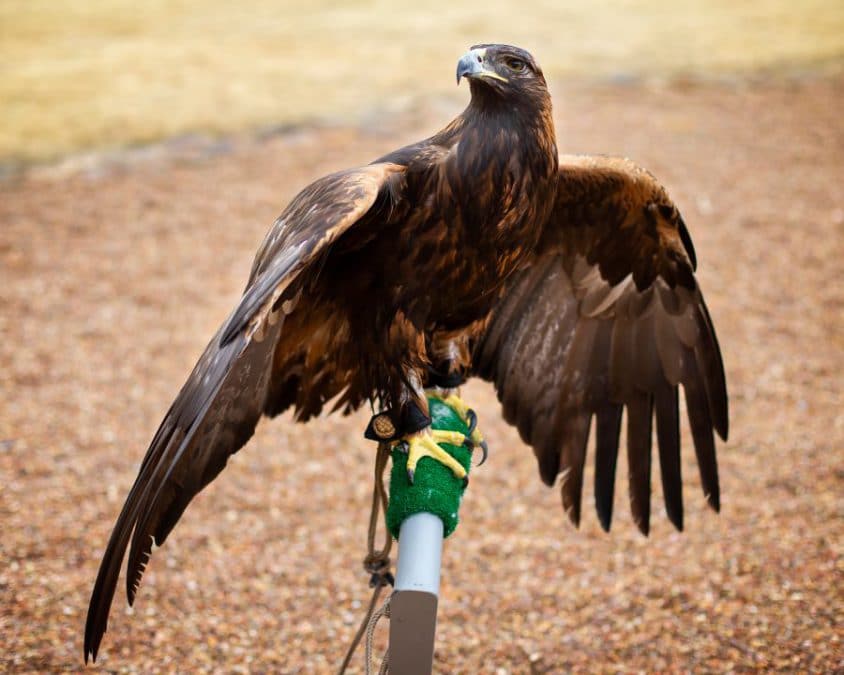Offering a natural environment with ample development opportunities for the eagles and other birds of prey that call the Citizen Potawatomi Nation Eagle Aviary home is one of the staff’s top priorities. Mindful approaches to both the design and implementation of the aviary’s enclosures keeps the birds in shape, both mentally and physically.
“Providing them with natural perching, trees and grasses and a running stream is not only good for enrichment but for their overall health,” explained CPN Eagle Aviary Manager Jennifer Randell.
Incorporating plants and other natural elements into the aviary’s facilities creates opportunities for the birds to maintain their beaks, feet and talons as they would in the wild. It also encourages the birds to practice their natural instincts, like nesting by pulling grass and collecting sticks.
“We make sure to have things that are intended for that purpose and are safe for them,” Randell said. “Having different levels and heights for perching with a variety of textures and surfaces offer them challenges and encourages them to move around the enclosure as temperatures and light or shade affect different surfaces throughout the year.”

It is also important that birds socialized to people receive regular human interaction.
“The daily feeding is also something that gives them a lot of enrichment,” Randell said. “We also work to provide a variety of different food throughout the year.”
Aviary staff are conscious of the different needs for the bald and golden eagles in their care, developing activities specific to each.
“Bald eagles are given live fish in their streams, whereas the golden eagles do not eat fish,” Randell said. “We have to find more creative ways to give them enrichment. Again, a natural environment with trees, sticks, rocks and other items they would have in the wild.”
Just like humans, the birds’ personalities are unique as the tasks they find entertaining.
“Our young bald eagle enjoys carrying the river rocks from the stream all around the enclosure and placing them where he sees fit. Most all of the birds enjoy the misters in the heat. Many of them, even in cooler months, will still go to the misters and wait for us to turn them on,” Randell said. “But everyone’s favorite activity has to be eating.”
The aviary is also home to several birds of prey outside of eagles, including an augur buzzard named Nikan, which translates as friend in Potawatomi.
“Nikan is what we refer to as imprinted on people and very much enjoys time spent out in the aviary pasture, exchanging sticks and nest building with one of the aviary staff,” Randell said. “He also likes some good time spent in the sprinkler during the hot summer months.”
Glove-trained birds, like the CPN Aviary’s golden eagle Myanabe, require additional training opportunities. Due to their social nature, they need more personal, human interaction to help them remain acclimated to a public setting.
“That means continually working with them on the glove,” Randell said. “Spending time to reinforce positive interactions with sights and sounds they will encounter during presentations keeps them comfortable.
“Our process of training is more about a relationship and time spent with a glove-trained bird because they are family. Most people can relate to horses and that reciprocity when you work with them. Raptors are much the same. That feedback loop is important; you get back what you put in, so being mindful of that is always a priority.”
Seasons
Weather and temperatures also influence what enrichment activities staff employ. During the summer, the excessive heat can prove difficult for training. Staff are mindful of the added stress heat brings and cannot be as hands on with the birds as they are during other seasons.
“Many people don’t know that an eagle’s body temperature runs about 106 degrees, so you can image how easily they could overheat in our Oklahoma summers,” Randell explained. “We turn a misting system on during these hotter months to help them cool down. Tours and interaction are also limited during the summer.”
The most opportune time of year to conduct training and incorporate exercises with the birds is during the cooler months or early spring and fall.
“The first and most important thing is to give these eagles a good life — a quality of life in captivity. The more positive enrichment and daily routine the better,” Randell said. “When we take these eagles in, we take them in as part of our family. They have been out there working for us, carrying our prayers and now it is our turn to take care them.”
Learn more about the CPN Eagle Aviary and the eagles and other birds of prey that call it home at potawatomiheritage.com.
